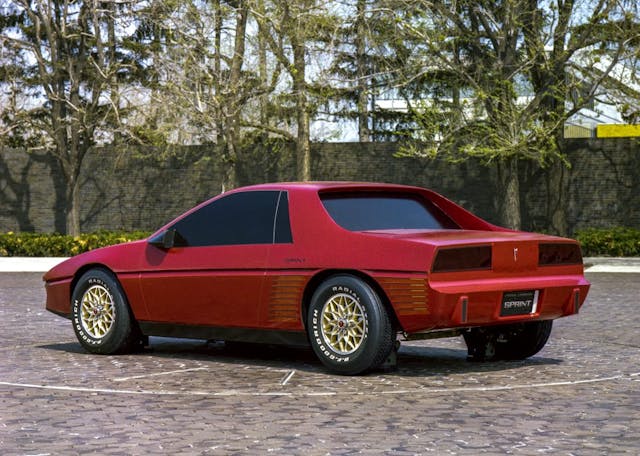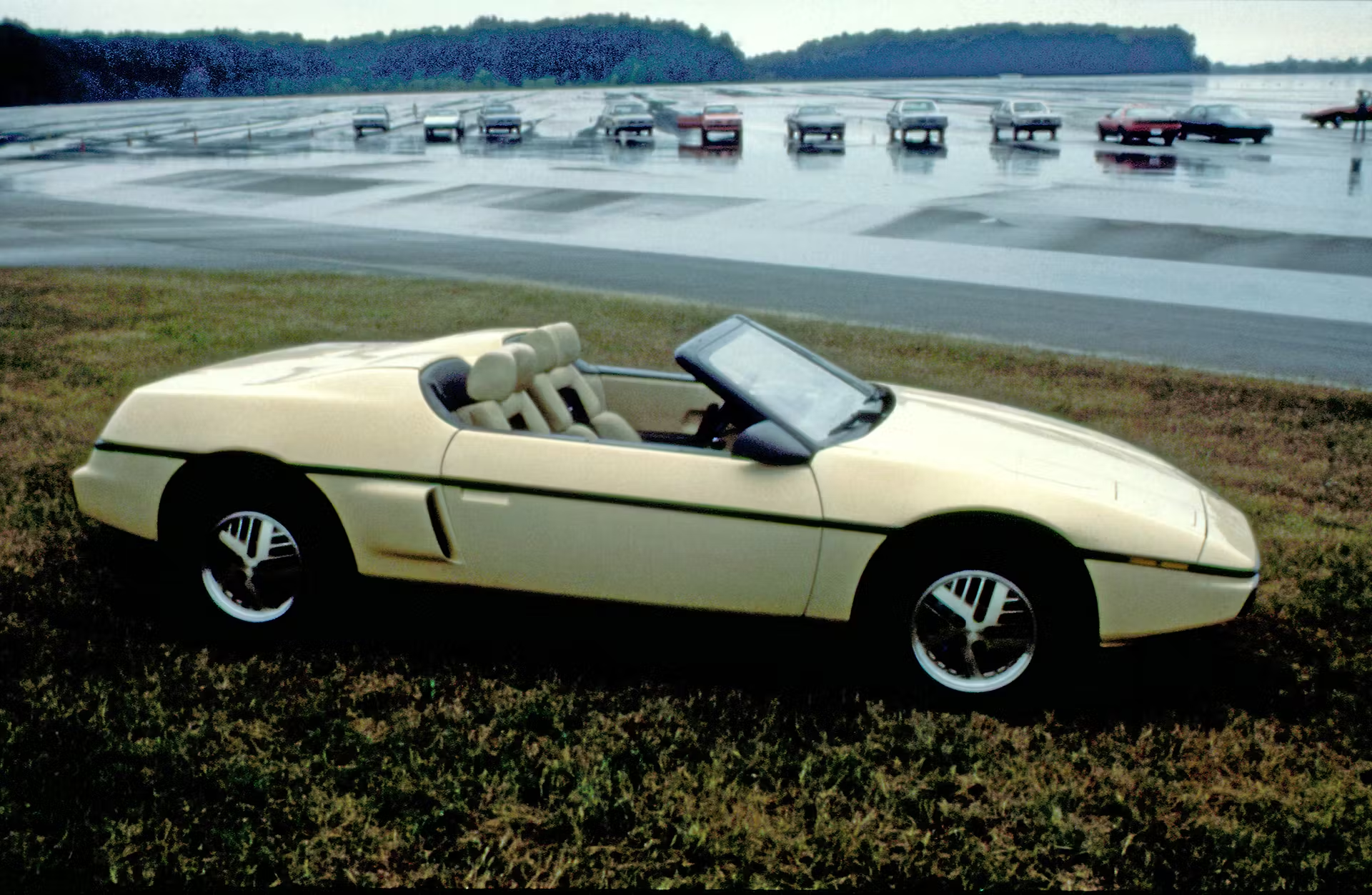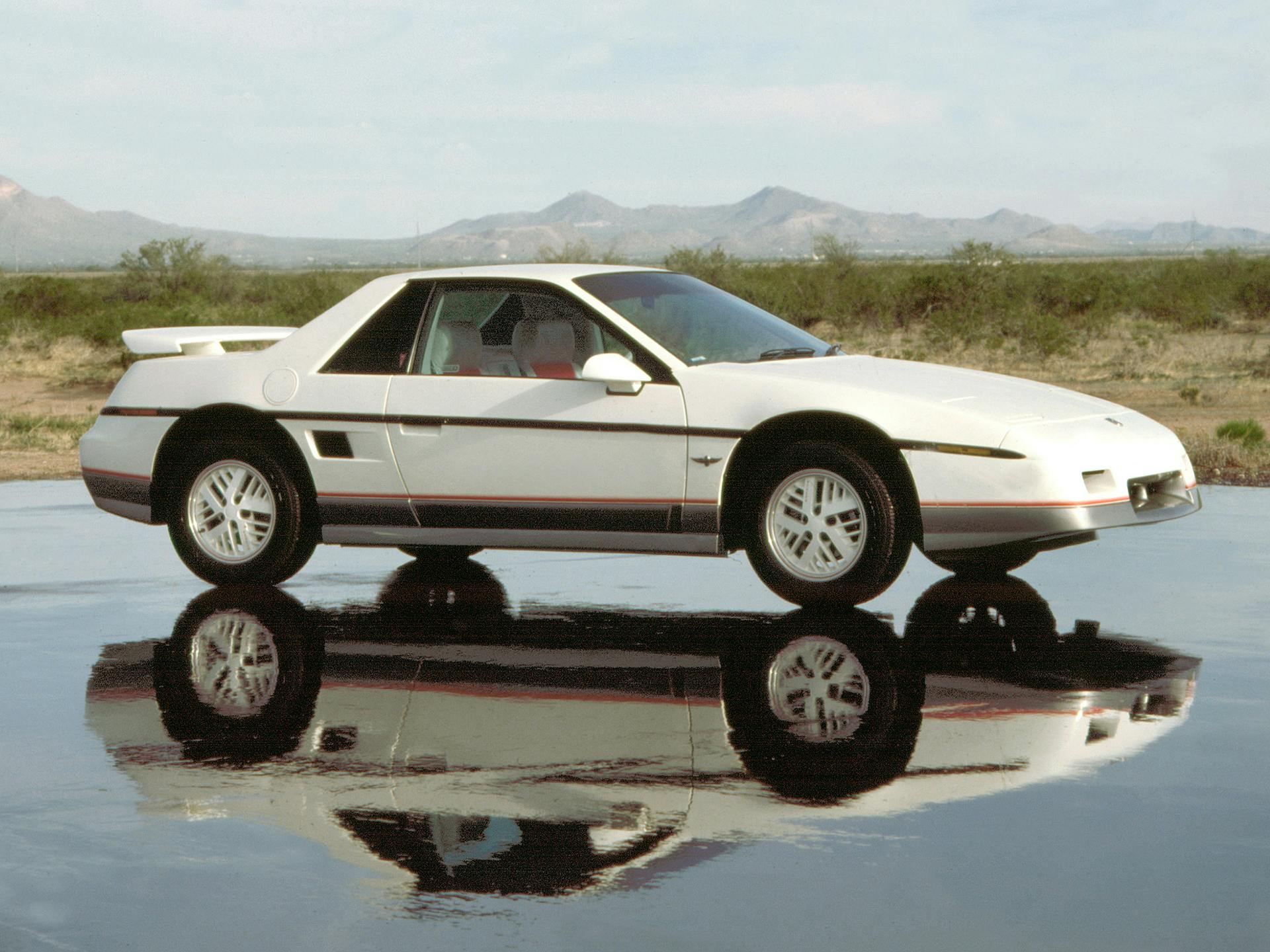Media | Articles
Pontiac’s mid-engine Fiero was a long time coming, and then it flamed out
We all know that General Motors finally did the mid-engine Corvette for which its first chief engineer, Zora Arkus-Duntov, lobbied through most of his career, and beyond. The C8 Corvette is indeed a reality, and it’s possibly the best sports car for the money in the whole world.
Don’t forget, though, that GM’s first mid-engine car launched 36 years earlier in 1984: the Pontiac Fiero. Sold to conservative GM corporate leaders by Pontiac Division as a fuel-efficient two-seat commuter with the compact X-car’s 2.5-liter four-cylinder engine and transaxle (four-speed manual or three-speed automatic) behind its cockpit, the Fiero would soon after evolve into a real sports car. The two-seater’s initial appeal was its styling (penned by John Schinella’s Firebird-famous studio) and affordability, but both engine performance and handling were improved with each model year. A svelte fastback GT model and available 2.8-liter V-6 power followed, and the Pontiac even racked up some credible racing credentials. Nevertheless, like all other two-seaters except the Corvette, GM killed it after five model years.

How did this bright idea turn into a money loser with a poor quality reputation? To put it simply: cost-cutting. Fiero’s steel space frame wore a plastic skin for low tooling cost, rust- and dent-resistance, easy replacement, and inexpensive restyling. GM thought this was the way of the future and later built some minivans the same way. The Fiero used a lot of GM parts-bin components—including X-car front suspension turned 180 degrees in back (along with the engine/transaxle) and subcompact Chevette short/long-arm suspension with rack-and-pinion steering up front—again, to keep its cost down.
Take one: A tough case to make
Just getting the Fiero approved was a difficult prospect from the outset, and doing so required compromise and sacrifice. Remember, GM in those days had five car divisions led by general managers with corporate VP titles and company president power, all operating almost independently with product lines that overlapped and often competed with one another. Each division did most of its own engineering—including designing, developing and building its own engines—but the GM dictated what products each division could work on and allocated money for them.
Pontiac, sitting between low-price Chevrolet and near-luxury Oldsmobile, wanted to distinguish itself as a youthful and sporty brand. “I’d been pushing for a two-seater for years,” said Elliott M. “Pete” Estes, who was Pontiac chief engineer from 1956–61 and then general manager from 1961–65. “But [they] would look at the market and say, ‘What the heck do we want to get into that business for? The Corvette’s covering part of that segment anyway.’ My idea, though, was to get into a different end of the market, put together a toy for the kids in college or high school, and try to keep the price way down below the Corvette’s.”
Marketplace
Buy and sell classics with confidence

Estes and his chief engineer, the up-and-coming John Z. DeLorean, got serious about a two-seater in early 1963. They had Dick Denzer’s Advanced Engineering Group cobble up an experimental chassis (coded XP-833) and ship it to GM Design Staff, where Paul Gillan’s Advanced Studio crafted in clay a lovely little convertible with sweeping fenders—much like what would later distinguish the C3 Corvette in 1968.
Three test mules and two running prototypes were built: one powered by Pontiac’s soon-to-come 230-cubic-inch, SOHC inline-six, the other by a 360-cu-in V-8. Estes lobbied GM management to approve it for production, but it was an uphill battle from the start. Even the Corvette lost money in its early years, and Ford’s initial 1955–57 Thunderbird sold poorly compared to the ’58-and-later four-seat T-Birds.
When Estes was promoted to Chevrolet general manager in July 1965, the dynamic DeLorean moved up in rank to replace him. Ford’s youthful and affordable four-seat Mustang was by that point already a runaway success; Chevrolet was working hard on its competing Camaro; and DeLorean was more certain than ever that a fun, affordable two-seater would be just the ticket to establish Pontiac’s position in America’s fast-emerging youth market. According to an elaborate proposal put together by Bill Collins, the engineer who had led the XP-833 (now Banshee) program, it would use 80 percent production Tempest parts and wear a fiberglass skin over a steel structure, and it could be ready as a 1967 model. It would sell for around $2500, roughly equal to the Mustang and $500 less than the MGB, Triumph TR-4, and Austin Healey 3000 British roadsters of the day. GM brass, however, fed up with DeLorean’s persistence, instead offered a version of the Camaro that became the 1967 Firebird.
Take two: A move to mid-engine

A decade passed before a window opened for Pontiac’s would-be two-seater. In late 1978. Pontiac strategic planning manager Denny O’Donnell and his two-man staff, Donald “Parky” Parkinson and Tom Kalush, were brainstorming future product ideas for a quarterly Future Product Conference (FPC) led by Pete Estes, who was by then GM president. Estes had asked each division to propose long-range plans to meet accelerating Corporate Average Fuel Economy (CAFE) standards, and O’Donnell’s boss, Product Planning manager Courtney Jones, included something very different and special in Pontiac’s proposal.
“We were coming down to the wire,” O’Donnell said. “FPC was a week away. Finally, late one night, the three of us were in a little back room at Product Planning, trying to figure out what we could write into this pitch for Courtney that would meet his requirements.”
As Kalush recalled, “We wanted to put together a very competitive, aggressive product lineup that would also hit our CAFE targets. Suddenly Denny said, ‘Hey, we ought to dust off the old two-passenger sports-car idea!’ A light little car like that would give us good fuel economy in what we thought would be a very marketable product.” Of course, Estes was inclined to such a vehicle.
At the October 1978 FPC, Pontiac once again pitched a two-seater, this time with a GM president at the other end of the table who had requested the same thing a decade prior. Jones described it as a small, sporty commuter—not a sports car. According to O’Donnell, Estes said: ‘I see you’ve got my two-passenger car in there. Not so dumb.’” Estes suggested building a concept car to demonstrate to the Product Policy Group (PPG).

Parkinson put together a presentation that he showed to Worldwide Product Planning, Design Staff, and other corporate staffs, which generated some buzz. His plan was to graft a sporty body onto a front-wheel-drive “J-Car” (the eventual 1982 Chevrolet Cavalier/Pontiac Sunbird/Oldsmobile Firenza/Buick Skyhawk/Cadillac Cimarron) platform, the same way Ford had created the two-seat Ford EXP and Mercury LN-7 on the bones of its front-drive Escort.
Enter Turkish-born ace engineer Hulki Aldikacti, who had dreamed for years of creating exactly the car Parkinson was pushing. “As soon as Hulki heard about what we’d proposed, his eyes lit up,” O’Donnell recalled. Aldikacti asked GM Advanced Design Studio chief Ron Hill to explore a look for the little two-seater, but it wasn’t long before everyone agreed that the front-drive J-Car idea was flawed. Not only was its cowl (at the base of the windshield) too tall, its transverse engine and MacPherson strut front suspension would cause both aesthetic and aerodynamic problems.
“You put a tall hood on a short car and it looks like a midget truck,” Hulki said, “Shorten a front-engine car, it looks ugly. We had to find a different combination to make the car look right—a mid-engine design. It’s an obvious engineering solution. The Fiat X1/9 was done the same way.” Hulki had the shop bolt an X-Car engine and powerplant cradle on the back of a chassis plate and build a plywood “stick” car around them. The setup looked promising.

By that time, Pontiac had a new general manager, Bob Stempel, a strong product man and auto enthusiast. Stempel was so impressed with the mockup he grinned ear-to-ear when he first saw it, and it wasn’t long before he pitched it to Estes, GM president. Pontiac execs figured it would cost about a million to build a prototype, and Estes quipped that a creative general manager and chief engineer should be able to scrape up that much. “That was all Hulki needed,” said O’Donnell. “He went off like a firecracker, hell-bent for election.”
Over the next four years, Aldikacti and his top assistant, Ed Falardeau, would engineer this two-seat “P-Car,” or “P-body” program and a whole new way to produce it. Hill’s advanced designers would shape it; John Schinella’s Pontiac production studio would fine-tune its appearance; Stempel would protect, nurture, and champion it through early development; and Parkinson would sell and resell it almost continuously until it reached production. It was a team effort, with buy-in from all corners of Pontiac.
Fine style, fiery name, and unique build
When production approval finally came in April 1980, the P-Car moved from Hill’s Advanced Studio to Schinella’s Pontiac Exteriors II (which also did the Firebirds and Trans Ams) and Pat Furey’s Pontiac Interior studios. The two toughest changes Schinella’s team had to make were moving the cockpit forward and increasing the windshield angle to a fast 63 degrees, which helped the car’s looks and improved its weight distribution and aerodynamics.
“The roof got changed in section,” Schinella explained, “and we extended the length of the windshield in plan view. That shortened the hood, and then we cut five inches off the nose. We were trying to find the right proportion with a longer tail and shorter front end because the car looked a little strange with a long nose. We wanted to give it more of a mid-engine look, and mid-engine cars seem to enjoy a longer higher rear. This got us right down to some magic dimensions that people liked, and it helped the car a lot.”

Inside, the car got new electronically driven gauges (no cables), new radios and heater/air conditioning controls, “aircraft-look” inner door handles, and new-design seats. “We’re really proud of the development that went into the seats,” said Bill Scott, who took over the interior studio after Furey moved to Chevrolet. “They’re Lear-Siegler seats, but Fisher Body was involved in the engineering development, and so was Pontiac. We were developing this new philosophy of contoured seats for Pontiac, and we wanted the ones in this car to be especially good.” Scott’s studio also developed an optional fleece seat insert and the Jon Albert-designed winged stallion logo.

Why a horse logo? Because at that point, the car was going to be called Pegasus. Other ideas included Sprint and Sunfire, and designer Schinella proposed Fiamma. “It means ‘first love of the heart, flame, excitement,’ in Italian,” he related. But the dealers hated that one. They thought it ought to be something like Firebird XP. “In the studio,” Schinella continued, “we all felt an Italian name was very appropriate, especially with a few of us being of Italian descent. That next Saturday, while thumbing through the Italian dictionary at home … I tripped on the word Fiero. It means ‘very proud.’”
To settle on a name, the team piled into a room behind a locked the door and wouldn’t leave until a decision was made. Each name was up on the wall, and team members had five minutes to sell their favorite. It came down to three: Fiamma, Sunfire, and Fiero. Fiamma was maybe a bit sleek, Sunfire too dated. Fiero was the one.
Aldikacti and his assistant developed the build process, which was cutting-edge for a production vehicle. Borrowing from methods used in race-car construction, they gave it a full space-frame structure completely independent of its outer body panels. The inner metal frame carried the exterior plastic panels, which were fastened with a quick-mount system. The result was well-managed surface seams and alignments to within thousandths of an inch.
Despite tough market conditions and GM’s first red-ink year in modern times—during a deep economic recession in the early 1980s, a nerve-wracking string of delays and cancellations, a new Pontiac general manager, two new chief engineers, and a new vehicle chief engineer—the Fiero came to market in the fall of 1983, as a 1984 model. This “commuter car” was no doubt one of GM’s best-looking products on four wheels, powered by a 92-hp 2.5-liter four and wearing a reasonable $7999 price tag.
Burned up in a flash

The Fiero surged off to a surprisingly strong start in its debut year, with 136,840 built and sold, but quality problems and engine issues soon damaged its reputation. The four-cylinder suffered oil starvation issues (the result of an incorrectly marked dipstick, as well as early official owner and service manuals indicating a three-quart oil pan, rather than the actual four) and there were other issues that even resulted in fires. Production fell nearly in half to 76,371 for 1985, despite the arrival of the sports-car quick and agile GT model, motivated by a 140-hp 2.8-liter V-6, which accounted for 22,534 of that total. Sales recovered slightly for 1986, before dropping off severely in the subsequent years until GM stopped the bleeding after the 1988 model year.
Other than the Corvette, GM’s two-seater track record is spotty at best. Following the Fiero were the Buick Reatta and Cadillac Allanté, followed by the Corvette-based XLR. None were successful, and even the Bob Lutz-backed Pontiac Solstice and its derivatives hardly fared better. The Fiero was a brave and hopeful idea with genuine support, but despite the little Pontiac’s obvious advancements and V-6 spunk, the promising project ended just how GM brass in the ’60s feared it would.

















































The first time I saw a fiero was in UAE 30 years ago, playing in the holiday Inn, playing Music/entertaining
Duet, nice little car, rear engined and sporty looking, unfortunately it wasn’t practical to buy and ship, too expensive, after purchase,
I never bought the dramatic finding of the Fiero name by John in an Italian dictionary late at night.
Why? Pontiac had a Fiero back in 1969 that was a Firebird with an Aero package on it.
Firebird = Fi. Aero = ero Fir + ero is Fiero.
I expect the name needed changed for a reason never disclosed from Pegasus and they had a list of copyrighted names controlled by GM to choose from.